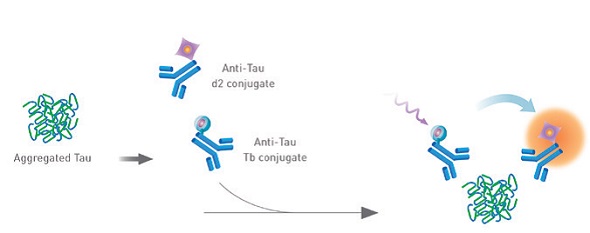Human brain consists of microtubule structures to support the transport of nutrients between neurons, and these structures are stabilized by the tau protein. The microtubule structures and nutrient transport will be collapsed in the presence of abnormal tau protein, leading to the development of plaques. This condition can be observed in patients suffering from neurodegenerative diseases such as Alzheimer´s.
Therefore, it is possible to know about the neurodegenerative disease state of patients from their tau protein level. In this regard, a tau aggregation kit has been developed by Cisbio for applications in recombinant proteins, brain tissue extracts, and cell cultures.
Assay Principle
A sandwich immunoassay is used to measure tau aggregates through the application of an anti-tau monoclonal antibody that is labeled either with d2 or terbium-cryptate in order to ensure signal quality and assay quality reproducibility. The specific HTRF signal produced varies in proportion to the quantity of tau aggregates, as shown in Figure 1.

Figure 1. HTRF® tau aggregation assay principle. Image credits: BMG Labtech
In the presence of closely spaced d2 and terbium-cryptate, an energy (FRET) is transferred to the HTRF acceptor when the HTRF donor is excited by a flash lamp or laser, resulting in a specific 665nm FRET signal. The measurement of the donor emission is carried out at 620nm wavelength. The steps to perform tau aggregation assay protocol are depicted in Figure 2.

Figure 2. HTRF® mix and measure protocol. Image credits: BMG Labtech
Instrumentation
Cisbio’s TAU aggregation assay kit (#6FTAUPEG) equipped with a white 384-well low volume microplate and BMG LABTECH’s PHERAstar FS microplate reader are used in this analysis. The instrument settings are listed in the following table:
|
Detection method
|
Time-resolved fluorescence, endpoint
|
|
Optic
|
Top optic
|
|
Optic module
|
HTRF 337 665 620
|
|
Integration start
|
60μs
|
|
Integration time
|
400μs
|
|
Excitation source
|
Laser or flash lamp
|
|
Simultaneous dual emission
|
Yes
|
Experimental Procedure
The sample volume required is 10μl, and the sample is fed into a well of a 384-well plate. This is followed by adding 5μl anti-tau-d2 antibody and 5μl anti-tau-tb antibody, and incubating the sample mixture at room temperature for 2 hours. The PHERAstar FS microplate reader is used to measure the resulting HTRF signals. The MARS Data Analysis Software automatically converts the results of the two emission signals to HTRF Ratio or DeltaF% values.
Experimental Results
Assay Specificity and Linearity
The assay is able to clearly differentiate between samples consisting of chemically aggregated tau and non-aggregated tau, as shown in Figure 3. HTRF values of aggregated tau samples significantly vary with concentration, while such a level of increase is not observed in the case of non-aggregated tau. A linear relationship is observed for tau aggregation.

Figure 3. DeltaF% values obtained for aggregated tau and non-aggregated tau. Image credits: BMG Labtech
Kinetics of Tau Aggregation
Aggregates of recombinant full-length human tau protein were obtained using chemical aggregation. Kinetic parameters were evaluated by preparing five samples in parallel and stopping the reaction at various time points, ranging from 1 to 24 hours, as shown in Figure 4.

Figure 4. Kinetics of tau aggregation. Image credits: BMG Labtech.
A kinetic of dissociation can also be monitored following the addition of compounds, using this assay system.
Tau Aggregation on Transgenic Mouse Brain Extracts
Here, brain extract samples obtained from transgenic mice (Tau/PSEN2/APP) were analyzed for tau aggregation, showing the development of neurodegeneration pathology over time. From Figure 5, the assay not only allows detecting tau aggregates in late stages (red bars), but is also specific enough to differentiate between the early stages of tau fibrillization (yellow and blue bars).

Figure 5. Tau aggregation of transgenic mouse brain extracts. Image credits: BMG Labtech.
Conclusion
This article has demonstrated the successful measurement of tau aggregation using the PHERAstar FS microplate reader. The assay system requires very small sample volume of less than 10μl, making it suitable to detect early stage fibrillization. A sample can be measured several times with no effect of bleaching, thanks to the HTRF technology. This capability of the HTRF chemicals enables real-time monitoring of tau aggregation by allowing kinetic measurements.
Acknowledgements
Produced from materials authored by Delphine Jaga1 and Franka Maurer2 from:
1Cisbio Bioassays, France
2BMG LABTECH, Germany
About BMG Labtech

BMG LABTECH has been committed to producing microplate readers for more than twenty years. By focusing on the needs of the scientific community, the company’s innovative microplate readers have earned the company the reputation of being a technology leader in the field.
BMG LABTECH has developed a wide range of dedicated and multi-mode microplate readers for life sciences applications and high-throughput screening.
All BMG LABTECH microplate readers are "Made in Germany" and are conceived, developed, assembled, and tested entirely at our headquarters in Germany.
Since our establishment in Offenburg, Germany in 1989, BMG LABTECH has expanded to offer a worldwide sales and support network with offices in the USA, UK, Australia, Japan and France. Our subsidiaries, regional offices and distributors are committed to bringing you innovative microplate reader technology with the quality and reliability you expect from a German company.
Our staff includes engineers and scientists from the fields of biology, biochemistry, analytical chemistry, and physics.
Sponsored Content Policy: News-Medical.net publishes articles and related content that may be derived from sources where we have existing commercial relationships, provided such content adds value to the core editorial ethos of News-Medical.Net which is to educate and inform site visitors interested in medical research, science, medical devices and treatments.